Monuments in Bengaluru
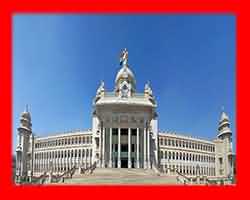 Vidhana Soudha
Vidhana Soudha
This is the administrative building of the State Government of Karnataka. It houses the state legislature and the secretariat. The magnificent structure was constructed in the year 1956 when the ruling Wodeyar dynasty transferred power to the central government. The then chief minister of the state, Kengal Hanumanthaiah had symbolized the structure as the reflection of power and dignity of the people. On every Sunday the building looks spectacular with illumination.
The Vidhana Soudha has four floors above and one floor below ground level and sprawls across an area of 2,300 by 1,150 feet (700 m × 350 m). It is the largest Legislative building in India. Its eastern face has a porch with 12 granite columns, 40 feet (12 m) feet tall. Leading to the foyer is a flight of stairs with 45 steps, more than 200 feet (61 m) wide. The central dome, 60 feet (18 m) in diameter, is crowned by a likeness of the Indian national emblem. The front of the building is inscribed with the words Government's Work is God's Work.

 Tipu Sultan's Palace
Tipu Sultan's Palace
This grand palace of Tipu Sultan is situated near Albert Victor Road in Bangalore. It is made up of teak wood with floral patterns on the walls and ceilings. This two-storied structure is a replica of the Daria Daulat Bagh in Srirangapattana which was the summer retreat of Tipu Sultan. The magnificent structure was called as Envy of Heaven by the king. After the death of Tipu Sultan the palace was used as an administrative building by the British. The palace is open to visitors from Saturday to Thursday. Entry is based on tickets.
Tipu Sultan's Summer Palace, in Bangalore, India, is an example of Indo-Islamic architecture and was the summer residence of the Mysorean ruler Tipu Sultan. Hyder Ali commenced its construction within the walls of the Bangalore Fort, and it was completed during the reign of Tipu Sultan in 1791. After Tipu Sultan's death in the Fourth Anglo-Mysore War, the British Administration used the palace for its Secretariat before moving to Attara Kacheri in 1868. Today the government of Karnataka maintains the palace, which is located at the center of Old Bangalore near the Kalasipalyam bus stand, as a tourist spot.

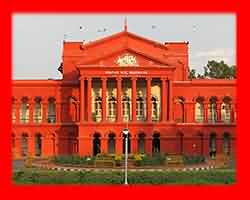 Attar Kacheri (High Court)
Attar Kacheri (High Court)
The red two storeyed building known as "Attar Kacheri" is the high court of the state of Karnataka. It was completed in the year 1864 and housed the public offices from 1868 to 1956. On the ceiling of its Central Hall you can see the portrait of Sir Mark Cubbon, commissioner of Mysore from 1834 to 1861. The Corinthian columns present in the building are wonderful. Behind the building you can also see the statue of Sir Mark Cubbon designed by Baron Marochetti. Attara Kacheri of Bangalore was built under the reign of Tipu Sultan, the Emperor of Mysore. It is said that during his time, the offices of the eighteen departments of Revenue and General Secretariat expanded to quite an extent. Since the palace could not house the offices, he ordered the construction of a new building, where the offices could be relocated. He named the building as Attara Kacheri, meaning eighteen offices or departments.
The Karnataka High Court is the High Court of the Indian state of Karnataka. The High Court functions out of a red brick building known as Attara Kacheri. It is in front of Vidhana Soudha, which is the seat of the legislature of Karnataka.The Karnataka High Court is currently functional in Bangalore, Hubli-Dharwad and Gulbarga.

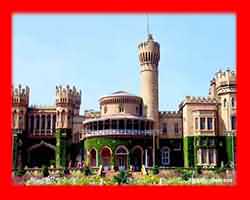 Bangalore Palace
Bangalore Palace
Bengaluru Palace, a palace located in Bengaluru, India, was built by Rev. Garrett, who was the first Principal of the Central High School in Bangalore, now known as Central College.
The Bangalore Palace is a worth exploring monument situated at Palace Guttahalli in Bangalore. Bangalore Palace It was built by Chamaraja Wodeyar, Maharaja of Mysore in 1887. The Palace has turreted parapets, battlements, fortified towers and arches. The palace was constructed at a price of Rs. One lakh. The king Chamaraja Wodeyar, during his visit to England had seen several structures of architectural importance but was greatly inspired by the Windsor Castle in London; hence he decided to build a palace in Tudor style. The entire palace is spread over an area of about 430 acres; the Palace is famous for its elegantly carved woodwork. It is surrounded by a garden all around, almost giving it a fairytale setting. The structure has fortified towers decorated with Gothic windows, battlements and turrets. Thanks to the king for his endeavor in bringing such a beautiful palace.

 Nehru Planetarium
Nehru Planetarium
Jawaharlal Nehru Planetarium is situated in the heart of the city of Bangalore. The regular shows of the planetarium are Nehru Planetarium based on various themes of astronomy- twinkling stars, meteoroids, comets, constellations, rotating solar system and other cosmic events. It provides knowledge to students and general mass about astronomical and cosmic events happening in the universe. The lectures and shows on astronomy are regular features. The dome of the planetarium is 15 metres in diameter and has a seating capacity of 225 persons. It holds two shows on daily basis and conducts special shows for school children. The planetarium remains closed on Mondays and 2nd Tuesdays. Just opposite to Nehru Planetarium, a new attraction called "Musical Dancing Fountain" is a must to see while visiting the planetarium.
Jawaharlal Nehru Planetarium (Jawaharlal Nehru Planetarium), Bangalore, was established in 1989 by the Bangalore City Corporation, now known as the Bruhat Bengaluru Mahanagara Palike (BBMP). The administration of the planetarium was entrusted to Bangalore Association for Science Education (BASE) which was formed in 1992. BASE is an Autonomous Body which is registered under Karnataka Societies' Registration Act. It is principally supported by annual grants from the Department of Science and Technology, Government of Karnataka.

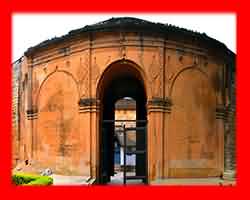 Old Dungeon Fort and Gates
Old Dungeon Fort and Gates
After the fall of Vijayanagara Empire, Kempegowda (circa A.D.1510-1570), Prabhu of Yelahanka and ancestor of Magadi chiefs, built a mud fort and laid a firm foundation for Building Township which after three centuries developed into the modern city of Bangalore. The form of the fort is oval with round towers at proper intervals. For a short period the city was occupied successively by Shahji, father of Shivaji, the Wodeyars of Mysore alternating with the Marathas and the Mughals.
Later, it was sold by the Mughals to Chikkadevaraja Wodeyar of Mysore for Rs. 3 lakhs. He built another fort adjacent to the old fort and also built the famous temple dedicated to Venkaramanaswamy which is even now under worship. Chikkadevaraja was succeeded by weak rulers providing a good opportunity to Haider Ali (A.D. 1761-1782). During his tenure, Bangalore received utmost attention as a strategic point. He had to fight the British in the first two Mysore Wars. The fort built by Chikkadevaraja was further strengthened by providing cyclopean stone veneering. Haider Ali also laid a beautiful garden known as Lalbagh which to this day survives in all its splendour. During the time of Tipu Sultan, Laid Cornwallis during the third Mysore War bombarded and damaged the Bangalore fort. Some portions of the fort were dismantled at the behest of Tipu Sultan to contain the Britishers from occupying it.
Although efforts were made to rebuild the damaged fort after the Mysore Wars, nothing remains now except a small round bastion and the facade of the famous Mysore Gate towards south. The gate facing south has an arched opening. Remains of high quality cut plaster work once embellishing the gateway could be seen in patches on its either side. A small temple dedicated to Ganesha abuts the wall. Some of the cyclopean members of the extant fort contain bas reliefs depicting man attacking tiger. The dungeon inside has a memorial tablet mentioning that Sir David Baird with others were confined here prior to March 1785A.D. Another tablet on the fort mentions that Lord Cornwallis affected a breach through which he entered and took possession of the city.

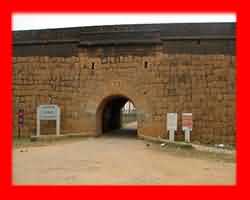 Devanahalli Fort
Devanahalli Fort
Devanahalli Fort is located 35 kilometers (22 mi) north of Bangalore city, at Devanahalli in the State of Karnataka, India.
It was originally built in 1501 by Mallabairegowda, which remained in the hands of his descendants until the mid–eighteenth century. In 1749, the then Dalwai of Mysore, Nanjarajaiah, attacked the fort and occupied it.
Later, the fort passed into the hands of Hyder Ali and subsequently Tipu Sultan. In 1791, Lord Cornwallis laid siege to the fort and took possession during the Anglo - Mysore War.
The birthplace of Tipu Sultan, also known as Tiger of Mysore, is located near to the fort. The fort is situated on the side of National Highway 7, near the Bengaluru International Airport.
An Archeological Survey of India (ASI) board outside the fort and at Tipu Sultan's birthplace declares them to be protected monuments.
